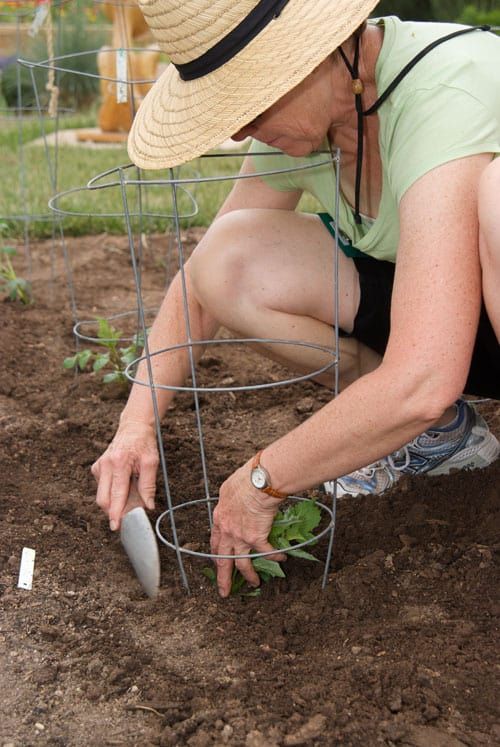Community gardens provide access to land


Community gardens continue to rise in popularity throughout Boulder County and Northern Colorado. They are sponsored by local governments, churches, schools, community centers, retirement communities and apartment complexes, with the same purpose in mind: to get people growing and eating fresh produce.
They are important because they give people access to a plot of land to grow food where they may not have other choices. Some people live in apartment complexes but are interested in growing more food than is allowed through container gardening. Others may live in established neighborhoods with lots of trees, which aren’t conducive to growing fresh fruits and vegetables. Whatever the reason, there are many opportunities in Boulder County, Fort Collins and Greeley to get involved in a community garden.
Greeley Neighborhood Resources manages 12 community gardens in Greeley. Houston Gardens is the oldest and was started in the 1970s. It has 25 community garden plots. The next oldest is at the University of Northern Colorado campus, with 24 plots.
SPONSORED CONTENT
How dispatchable resources enable the clean energy transition
Platte River must prepare for the retirement of 431 megawatts (MW) of dispatchable, coal-fired generation by the end of the decade and address more frequent extreme weather events that can bring dark calms (periods when there is no sun or wind).
“Each one of these community gardens is managed in different ways. The ones I manage, people are truly leasing the plot of land and they are responsible for planting and maintaining and harvesting and cleaning up,” said Deborah DeBoutez, neighborhood resource officer with the city of Greeley. “The only thing we do is provide access to water. But other community gardens have a requirement to donate a portion of your food to a food bank or other nonprofit. It just depends on who is managing the gardens.”
Growing your own food can help with a person’s food budget. It also is healthier. The most important reason to get involved in a community garden is that “it really brings a group of people together that wouldn’t otherwise connect with each other. So you’ve got people of multi-generations, multi-cultures, multi-languages convening in one place with a common goal of growing their own fruit and vegetables. It is a really good community building tool,” DeBoutez said.
Greeley has reached its peak for community gardens, she said. In the past, there was a wait list for garden plots. This year, there are still openings. In the city of Greeley, there are still a few openings at the UNC garden. The other two DeBoutez manages are full. If you want to rent out a plot it is $25 a year. Check with the community garden you are interested in, however, because every garden manager has a different annual cost per plot.
Fort Collins has eight community gardens with 160 community garden plots, three of which are dedicated to growing food for the Larimer County Food Bank, said Vicki Cotton, guest services-community gardens administrator for the Gardens on Spring Creek. Many of the plots are worked by a group, like Elderhaus, veterans, Foothills Gateway, Linton Elementary and a local company that offers gardening as an activity for its staff.
Of the group’s eight gardens, three are full up, but five have garden plots available.
The Gardens on Spring Creek is a public/private partnership and serves as the community botanic garden in Fort Collins. One of its gardens, the Garden of Eatin’, is a ¾-acre garden that is dedicated to edible crops. It serves as a living classroom, a demonstration garden and it has a mandate to remain fully productive.
The bulk of the food from this garden goes to the food bank. The organization donated more than 6,000 pounds of premium produce to the food bank last year.
The Larimer County Food Bank approached the Gardens on Spring Creek in 2010 and asked if the gardens could come up with a plan for increasing the offerings of fresh produce that were already coming from the Gardens.
Mary Miller, community garden outreach coordinator for the Gardens on Spring Creek, said they started spreading the word around their community gardens and ended up collecting an additional 2,500 pounds of produce.
Now the Gardens on Spring Creek act as a drop-off point for community gardeners, home gardeners and small farms that have extra produce to donate or that can be persuaded to plant more to benefit the food bank.
“Last year, the community, including produce from the Garden of Eatin’, community wide, donated 40,000 pounds of premium produce. That is the Plant It Forward program,” she said.
Miller teaches classes and interfaces with the community at large. She also provides technical assistance for anyone who wants to create a community garden. She has been approached by churches, homeowners’ associations and low income housing developments about creating community gardens.
When the Gardens on Spring Creek opened in 2004, there were 35 community garden plots, but there was a huge waiting list every year to get one of those plots. In 2012 and 2013, the Gardens submitted a proposal to the Fort Collins City Council to pilot community gardens in the city’s parks. Now it has 160 plots in eight community gardens and the cost is only $25 a year with a $25 deposit. The deposit is rolled into the following year’s membership or is refunded to the gardener if they decide not to keep the plot the following year.
Each community gardener must give four hours of volunteer time in the communal spaces of the community garden, outside of their responsibility for their own plot.
Community gardens need to be resident-driven, she said. The city can’t just go in and say, we should put a community garden here. Instead, there was an application process for building new community gardens.
“We would like to build more but the funding stream is not there for us,” Miller said. “The truth is, to expand our community gardens to the level the community would like would require additional funding for staffing, which we do not have.”
Growing Gardens in Boulder was founded 20 years ago. The nonprofit was started to manage the city of Boulder’s community garden. It now manages that garden and 11 others throughout Longmont, Louisville, Lafayette, South Boulder and Boulder with more than 500 plots.
“We have over 1,000 community gardeners,” said Taylor Arenson, marketing and development manager for Growing Gardens in Boulder.
The group maintains a waitlist of people who would like a community garden plot. People can sign up for the list on Jan. 15 each year, but the group does give first preference to its current gardeners who want to renew.
“Some people have had plots for 20 years now,” she said. Once it has a confirmation on the number of community gardeners who are staying from the previous year, it opens up the rest of the plots to the waitlisted gardeners, who already chose the top three gardens they were interested in participating in.
Growing Gardens usually has a large waitlist of 80 people or more, but it does have turnover and those on the waitlist are sometimes absorbed by new community gardens that come online.
Each of the gardens comes with water so the garden plots cost $100 a year. Growing Gardens does offer low-income applications for reduced-rate plots.
Arenson, who is a community gardener herself, said she never expected to come into the community gardening world but “I have come to adore the community aspect of it. You get people from all walks of life, whatever that means, for better or worse, the culture of community created in the gardens is not something I experienced in other aspects of my life,” she said.
People chat with their neighbors, swap suggestions or best practices or share plant starts, she adds.
“Just sharing life with your gardening neighbors is a really special experience,” Arenson said.
Growing Gardens also has a program called The Food Project that provides food for low-income community members.
The gardens donate fresh produce but also seeds and plant starts so people can grow their own food. It also offers workshops so people can learn how to garden, or container garden, so they can grow the food their families need. Last year, Growing Gardens donated 17,000 pounds of fresh produce.

Community gardens continue to rise in popularity throughout Boulder County and Northern Colorado. They are sponsored by local governments, churches, schools, community centers, retirement communities and apartment complexes, with the same purpose in mind: to get people growing and eating fresh produce.
They are important because they give people access to a plot of land to grow food where they may not have other choices. Some people live in…
THIS ARTICLE IS FOR SUBSCRIBERS ONLY
Continue reading for less than $3 per week!
Get a month of award-winning local business news, trends and insights
Access award-winning content today!

